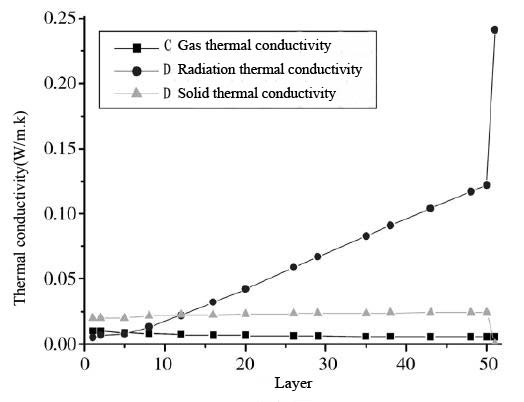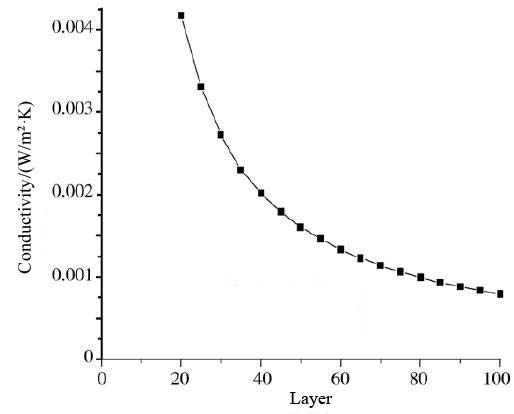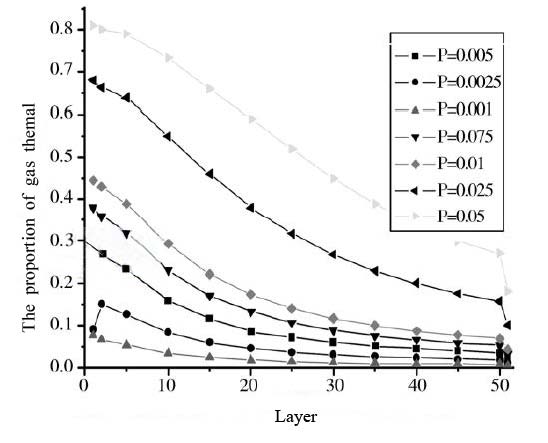
A Pipe Heat Insulation Device Featuring Vacuum Valve Box Structure
In order to solve the problem of heat insulation lifetime of low-temperature and vacuum pipes used by cryogenic liquefied natural gas (LNG) filing station, based on the theories of cryovacuum thermal insulation materials at home and abroad, through focusing on exploring such aspects as heat conduction of gas, heat insulating layer design and vacuum degree, Qingdao Luke Auto Gas Development Co., Ltd has developed one new type of pipe heat insulation device. The device is featured by the functions of unloading, pressure regulating and liquid adding, with prolonged life-cycle for vacuum insulation and better operability.
Keywords:
LNG filing Station, Heat insulation lifetime, Vacuum valve box, High Vacuum, Structural Design1. Introduction
As one kind of clean energy, natural gas (NG) has enjoyed great popularity. With the national energy demand increasing all the time, LNG has played an important role in optimizing the energy structure of China, effectively resolving the double issues of energy supply security and eco-environmental protection, and ensuring sustainable socio-economic development. It can be predicted that LNG will become the major driving force in the NG market of China in the following one or two decades.
However, in the design of LNG low-temperature conveying pipes, their cold insulation materials and structural forms have stood out as a critical issue, for they not only influence the conveying efficiency of low-temperature liquids, but also have a close bearing on the safe operation of the whole system. With sound thermal insulation performance, vacuum insulation pipes have been applied in the conveying pipelines of LNG, liquid oxygen (LOX) and liquid nitrogen (LN) in air separation plants. A new-type thermal insulation device featuring the vacuum box structure is designed with a larger vacuum thermal insulation cavity and less welding joints in order to ensure over 10 years of service life. This device has passed the test detection with LN, and an application for national invention patent has been filed and accepted by the National Patent Office as well. The Application Number is 201210237808.2.
In 2012, Qingdao Luke Auto Gas Development Co., Ltd marketed a device of thermal insulation for LNG pipes, which had gradually won the recognition of clients for its integrated design, greater effect of thermal insulation and reliable property. By the end of 2013, more than 50 units had been put on the market, and favorable feedback from the clients had been received, thus reaching the anticipated function benefits.
2. Introduction of Insulation Structure and Direction in Making Improvements
2. 1. Description of Insulation Structure and Existing Problems
Common devices of thermal insulation, using polyurethane (PU), foam glass, modified polyethylene and perlite as materials, have been applied earlier in the storage and transportation of low-temperature liquids. At the degree of -163℃, the thermal conductivity of some thermal insulation materials will be reduced to 0.0121W/(m.k) [1], their thickness of cold insulation layer to 100mm, and the amount of cold loss to 20w/m. Due to the fact that air circulation cannot be controlled within the mechanism of insulating through thermal insulation materials, the cold loss amount of thermal insulation will only be controlled to a limited degree even though the thickness of thermal insulation layer is increased. Moreover, in the transmission of low-temperature medium, the inner pipes would become contracted and deformed, the thermal insulation layer displaced and compressed, and the external protective coats (galvanized iron sheet or galvanized aluminum sheet) cracked through long time of use.
Pipes of low-temperature vacuum thermal insulation, thanks to their high performance in thermal insulation, can effectively increase the time of lossless storage, uplift the security of storage procedure, and gradually find wide application in the conveying pipelines of LNG, LO2 and LN2 in air separation plants.
But in consideration of the current situation of applications, low-temperature vacuum pipes also display some defects. Firstly, the duration of vacuum degree, 2 to 3 years on average, is relatively short. Once the duration of vacuum degree is short, frost will hang on the outer surface of pipes, which entails vacuum pumping all over again; however, on-site conditions like wetness degree make it hard to reach the requirements. Secondly, the valves on the process pipelines are separately installed in LNG filling stations, so it will be very inconvenient to operate. Thirdly, the workmanship of traditional vacuum pipes is very complex. Every inner pipe (LNG medium flow pipe) has to be covered by an outer pipe (vacuum protection pipe), which causes many pipes cross-linking and moving toward different directions. Therefore, in order to make sure the levelness and verticality of the pipes, plenty of frock clamps are needful. Besides, due to the complexity of technical control, it tends to incur the inner pipe being stretched, bringing about hidden dangers.
2. 2. Direction in Making Improvements
Through the above comparative analysis, it can be concluded that vacuum insulation is a relatively ideal way of thermal isolation. Based on the research results of high-vacuum and multi-layer thermal insulation materials at home and abroad, Qingdao Luke Auto Gas Development Co., Ltd has launched an exploration into developing, designing and manufacturing the filling station thermal insulation device featuring a longer duration of vacuum retention.
3. Explorations in Making Improvements
The structural design of thermal insulation devices for vacuum pipes has been conducted according to the principle of giving priority to theory. For high-vacuum and multi-layer cryogenic vessels, heat mainly transmits in three ways: (1) heat conduction of gas molecules [2,3]; (2) radiation heat transfer of reflecting screens; (3) heat conduction of interval insulants. Through experimental tests, the following aspects are verified in this paper, such as the influence of gas heat conduction, solid heat conduction of interval insulants and radiation heat transfer of high-vacuum and multi-layer cryogenic vessels, the proportion of gas heat conduction, solid heat conduction and radiation heat transfer respectively taking in the whole heat loss, the changes of heat transfer coefficient with the layers, and the impact of high vacuum on thermal insulation property. Consequently, the optimal design parameters are obtained.
3. 1. Temperature Distribution in Thermal Insulation Layers
When the temperatures at the cold and hot ends are respectively 77K and 300K, the number of insulating layers is 50, the duration of vacuum degree is 1x10-2Pa, and the thickness of insulating layers is 3cm, the temperature distribution of multi-layer thermal insulation materials at different positions is shown as in Figure 1. Through the Figure, it can be seen that the temperature difference of two neighboring thermal insulation materials at a low-temperature stage is larger than that at a high temperature stage.
3. 2. The Correlation between Thermal Conductivity and Position of Layers
When the temperatures at the cold and hot ends are respectively 77K and 300K, the number of insulating layers is 50, and the duration of vacuum degree is 5x10-3Pa, the changes of gas heat conduction coefficient, solid heat conduction coefficient and radiation heat transfer coefficient of multi-layer thermal insulation materials at different positions are shown as in Figure 2. Through the Figure, it can be seen that the solid and gas heat conduction coefficients have remained stable, but the radiation heat transfer coefficient has undergone obvious changes—the radiation heat transfer coefficient is rather small at a low-temperature stage, and its influence on the overall heat transfer is smaller than that of solid heat conduction, while at a high temperature stage, the radiation heat transfer coefficient witnesses a rapid increase, which far exceeds that of gas and solid heat conduction.
3. 3. The Correlation between Thermal Conductivity and the Number of Layers
When the temperatures at the cold and hot ends are respectively 77K and 300K, and the number of insulating layers is 5x10-3Pa, the changes of conductivity coefficient of multi-layer thermal insulation materials with the number of layers are shown as in Figure 3. Through the Figure, it can be seen that the overall conductivity coefficient decreases with increased insulating layers, but the decrease range of conductivity coefficient is becoming smaller and smaller with the increase of layers. With the number of insulating layers increasing from 20 to 50, the conductivity coefficient witnesses obvious changes accordingly. When the number of the layers increases from 50 to beyond, the changes of conductivity coefficient are not noticeable.
3. 4. The Correlations between Proportion of Heat Transfer by Gas and Vacuum Degree
When the temperatures at the cold and hot ends are respectively 77K and 300K, the number of insulating layers is 50, and the thickness of insulating layers is 3cm, the changes of the proportion of gas heat conduction with insulating layers are shown as in Figure 4. Through the Figure, it can be seen that the proportion of gas heat conductivity is becoming smaller and smaller with decreased vacuum degree—when the vacuum degree stands at 1x10-3(when the vacuum degree is 1.33x10-4Pa, the density of gas molecule number stands at only 3.24x1016/m3 [4] ), the proportion of gas heat conduction is far below 10%. When the vacuum degree is certain, the proportion of gas heat conduction is very large at a low-temperature stage and rather small at a high temperature stage with noticeable decrease.
Seen from the data obtained through the above experiments, the vacuum degree of designing a new type of thermal insulation device should at least reach 1x10-3Pa. Considering the fact that the gas and solid heat conduction coefficients vary little with the changes of temperature, and the radiation heat transfer coefficient is small at a low-temperature stage and large at a high temperature stage, the layer number of reflecting screens should be increased at a high temperature stage and meanwhile the number of insulating layers should be reduced to 50 in order to obtain the optimal insulating effects.
After completing the design scheme for internal insulating layers, the focus is shifted to the external structure of vacuum thermal insulation pipes at LNG filling stations (from the overall to specific). Can any breakthroughs be expected? The idea is to put operating pipelines inside a box-shaped container so as to reduce the welding joints of pipelines, because their gas tightness will influence the vacuum duration. According to the processing requirements, the structural size of the container has been initially designed, the cost-effectiveness of container vacuum pumping has been weighed, and the dimension of the container has therefore been determined.
In full consideration of insulating the connections between the vacuum container and the pump tank, vacuum structures have been adopted in the connecting flanges so as to ensure the insulating effects of the overall device. Excellent insulating effect means less heat exchange between cold source medium, which can help avoid vaporization and over-pressure and ensure safety of the device. To meet the requirements of design specifications, safe discharge equipment has been installed among the valves of the thermal insulation devices. Considering the contractability of low-temperature conveying lines, special-structure compensators have been put inside the pipes in order to ensure safe transmission of medium and guarantee its service life.
After completing the welding of vacuum thermal insulating valve box, a helium mass spectrometer leak detection has been carried out in order to check the gas tightness of stainless steel argon arc weldings. The leak rate is required to be below 2x10-10Pa.L/s, which suffices to ensure that the vacuum duration of the vacuum cavity will not decrease to less than what is required in 10 years.
4. Conclusion
Against the backdrop of national promotion of energy saving and emission reduction, reducing energy consumption has become a critical issue to be solved due to the continued decline of energy resources. In the petroleum industry, people have paid more and more attention to the thermal insulation of equipment and pipelines, thus placing higher requirements on the quality of products. When the work of insulation is properly handled, heat emission or absorption of equipment and pipelines to or from the surrounding environment in the process of production can not only be avoided for reduced energy consumption, but also the overall sensory quality of the project will be enhanced. The structure of vacuum thermal insulation valve box is a brand-new attempt at vacuum structures, and relatively ideal results have been obtained, but the steps of further explorations will never stop.
Notes
This is an Open Access article distributed under the terms of the Creative Commons Attribution Non-Commercial License (http://creativecommons.org/licenses/by-nc/3.0/), which permits unrestricted educational and non-commercial use, provided the original work is properly cited
References
-
Buchanan, R. (2001). Design Research and the New Learning. Design Issues, 17(4), 3-23.
[https://doi.org/10.1162/07479360152681056]

- Daoan, D. (1995). Manual of Vacuum Design. Beijing: National Defense Industry Press.
- Detian, L. (2013). New Technology of Vacuum Metrology. Beijing: National Defense Industry Press.
- Haicheng, X. (1995). Vacuum Low-temperature Technology and Equipment. Beijing: Metallurgical Industry Press.
- Peihui, Z. (2001). Low-temperature and Specialty Gas . Cryogenic Cooling Technique with Modified Polyurethane Foaming Plastic, (5), 32-34.



